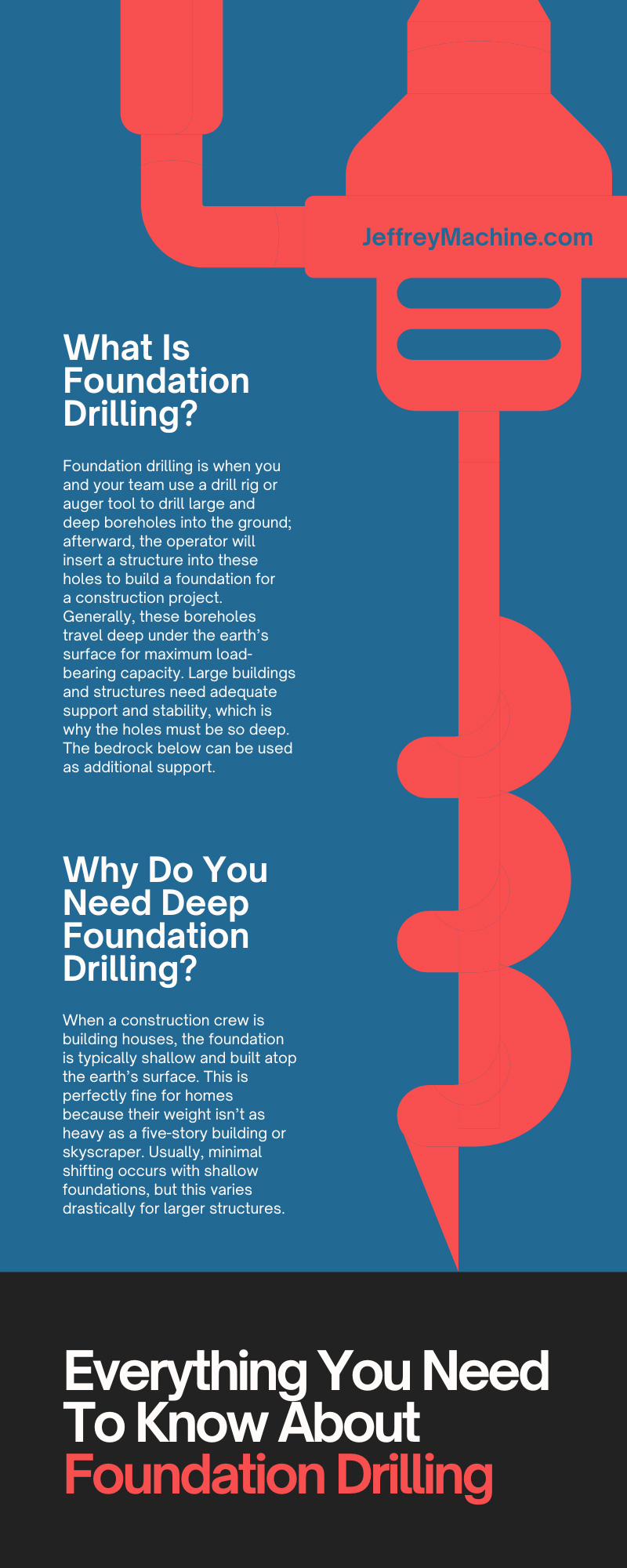Everything You Need To Know About Foundation Drilling

Foundation drilling is one of the most essential methods construction businesses use. Without it, we wouldn’t see the development of large office buildings, bridges, or skyscrapers. What is foundation drilling, and why do we use it? Are there different methods?
Dive into this article to learn everything you need to know about foundation drilling. Use this knowledge to ensure the success of your next project that requires foundation drilling.
What Is Foundation Drilling?
Foundation drilling is when you and your team use a drill rig or auger tool to drill large and deep boreholes into the ground; afterward, the operator will insert a structure into these holes to build a foundation for a construction project. Generally, these boreholes travel deep under the earth’s surface for maximum load-bearing capacity. Large buildings and structures need adequate support and stability, which is why the holes must be so deep. The bedrock below can be used as additional support.
This type of drilling can be done for new projects or pre-existing foundations. However, this practice is mainly used in new projects. Foundation drilling isn’t as simple as it seems. Many individuals, including the equipment operator, project manager, and site engineers, must coordinate to complete this project successfully.
Why Do You Need Deep Foundation Drilling?
When a construction crew is building houses, the foundation is typically shallow and built atop the earth’s surface. This is perfectly fine for homes because their weight isn’t as heavy as a five-story building or skyscraper. Usually, minimal shifting occurs with shallow foundations, but this varies drastically for larger structures.
Deep foundations are necessary for skyscrapers and tall buildings because they need additional support. This is also where foundation drilling comes in; without it, we wouldn’t be able to drill piles or piers into the ground for support. The foundation must be deep enough to prevent the structure from moving or sinking. Instead of allowing the whole weight of the structure to rest on a cement foundation, construction crews utilize the most immovable layer below them—the bedrock!
Examples of Foundation Drilling
A prevalent reason for construction crews to use foundation drilling is when they need to place utility poles in the ground. Utility lines and poles are all over America and are completely necessary to deliver power to cities and communities. These poles need to be sturdy enough to withstand various weather conditions and shifting soil. Due to this need, work crews will use the foundation drilling method to keep utility poles in place.
Remember that skyscraper we mentioned previously? It is a perfect example of foundation drilling. If your team were to construct a skyscraper on a shallow foundation, it could quickly become dangerous because the weight can threaten the structural integrity of the skyscraper. The building needs to utilize the process of deep foundation drilling to stay standing for many years and be safe for occupancy.
Did you think foundation drilling was only necessary for utility poles and large buildings? This construction process is also used in several other instances. You might use this method if your company constructs piers, bridges, or highways. In fact, some businesses might even use their foundation drilling equipment to divert groundwater away from homes or buildings at risk of water damage. As you can see, foundation drilling is extremely valuable in construction!
Various Foundation Drilling Methods
There is no singular method for foundation drilling. In fact, your construction crew could use several methods. Let’s take a look at the most common techniques.
Continuous Flight Auger
When you use an auger with continuous flighting, it simultaneously displaces the soil and rocks out of the borehole as you drill. However, the borehole can only be as deep and wide as the dimension of your auger parts. Generally, this method is best for cast-in-place piles or pre-drilling.
Grab Drilling
Grab drilling involves a claw in the shape of a sphere driven into the ground using a crane through a pre-placed casing. This is one of the oldest dry drilling methods construction businesses use. After the claw scoops up the soil and rock, you remove the drill from the hole, dispense the material, and repeat the process until the borehole is the correct size and depth.
Kelly Drilling
Kelly drilling creates large-diameter bored piles and is the most common method in the industry. This technique is appropriate for multiple types of rock and soil and uses various tools, such as augers and buckets, to successfully drill a hole for foundation purposes. For this method, insert a drill rod into the ground; after withdrawing the rod, lower a reinforcement into the hole and fill it with concrete to further set the structure.
What To Look For in Foundation Drilling Equipment
Your site conditions will vary depending on where a construction project is taking place. Therefore, the equipment you use from site-to-site changes. Vendors in the construction industry with years of experience can help you determine the type of machinery you need for your project.
Consider the vendor’s reputation, how they communicate, the equipment they have available, and whether they offer a service for repairs. These factors can help you find the perfect partner for your foundation drilling needs.
Other factors that affect your decision include the project’s location, the type of soil you’re drilling into, the depth and diameter of the hole, and the layout of your construction area. Keep in mind that one piece of equipment might work for one project but not the next.
Now that you know everything about foundation drilling, consider adding these tools to your equipment for better drilling:
- Buckets
- Core barrels
- Augers
- Casing spinners
You can also add these tools to your drill rig or upgrade components for more efficient drilling.
A significant component of construction work is ensuring the stability of the structure you’re building. This cannot happen if you ignore the importance of deep foundations for large structures and bridges. Use the knowledge you learned in this article to ensure the success of your next foundation drilling job.

